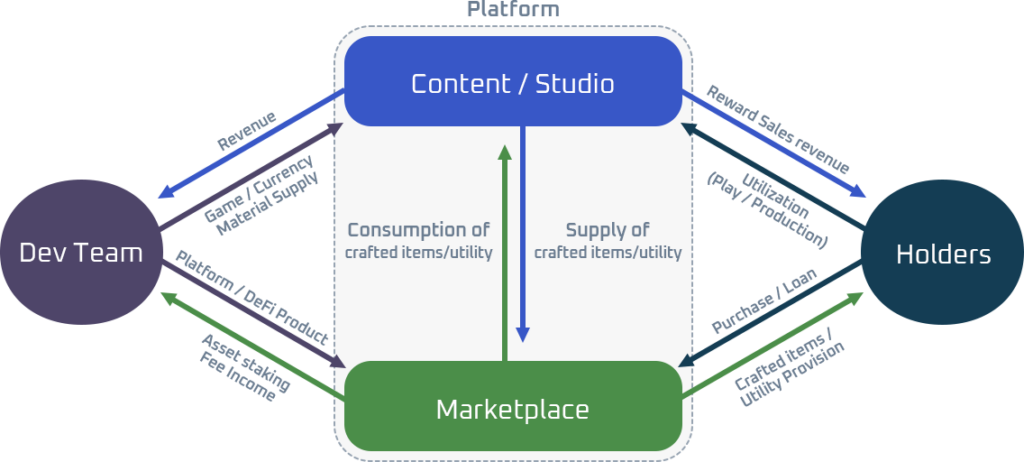
The GameFi gaming platform unique to Pixel Universe
We aim to create an economic ecosystem where each component and member is defined and assigned roles to make the GameFi ecosystem sustainable. We seek to foster growth through organic collaboration among various stakeholders.

The Components of GameFi
We are designing a sustainable economic ecosystem using games as a tool, structured similarly to real-world economic circulation models. This enables members to understand and quickly find roles that suit them, contributing to the development of the ecosystem.

Platform Structure


Economic Ecosystem Structure
Work
Members obtain goods in exchange for currency through activities such as gameplay or product creation. This currency is then used to purchase other products or materials for product creation. Alternatively, members may staking currency to pursue stable returns or higher profits.
Purchase
The products created by the development team or creators are purchased and utilized using currency.
Utilize or Consume
The purchased items are either used in games or production, or they are consumed. This automatically regulates the circulation of currency, thereby maintaining its value.
Staking
To pursue stable returns on owned currency, we introduce a staking system similar to commercial banks. This system is linked to market liquidity and offers varying returns based on the staking period. It is utilized to regulate the circulation of the currency and create a utility-focused economy within the ecosystem.
Loan
Owners can generate various revenue streams by leasing out NFTs, items, tools, or other assets with tangible utilities to other users.

Ecosystem contributors to Pixel Universe
😊Founders
They are responsible for creating and supplying the framework necessary for the initial ecosystem composition, ranging from content that ecosystem members can utilize to tools, rules, and platforms. They assign suitable roles to each member, provide assistance for smooth ecosystem development, and sometimes guide members’ behavior through appropriate intervention.
🗨️ Social Communicators
To further promote news about Pixel Universe, they analyze the ecosystem, provide opinions for better directions, and sometimes facilitate the integration of new players into the ecosystem through organic connections among players.
🕹️ F2P Players (for free)
They are traditional players who enjoy content by investing only their time. They enable stable player-versus-player structures through continuous and stable matchmaking services. Additionally, they provide the foundation for creating better ecosystem assets through actively trying out assets and games created by developers and providing feedback.
💎 F2P Players (with purchase)
These are players who purchase and own NFTs, assets, or products and can stake them. They have a good understanding of the economic ecosystem and actively utilize GameFi products to increase their assets. They act as another supplier within the ecosystem and play a crucial role in securing liquidity for PWC.
🧑💼 OG (Original Gangsters)
They are the initial supporters of our project, demonstrating high participation rates, engagement in numerous events, and a deep understanding of the ecosystem. As early participants in GameFi products, their opinions can significantly influence the future development direction of PixelPlay.
🤖 Creators
They supply the ecosystem with unique and highly utilitarian products by utilizing their creativity, as well as purchased or acquired materials and tools, to create various tools, items, and environments used in the ecosystem. They play a pioneering role in expanding the market to enhance the utility of PWC.
😎 Gamblers
These are players who are willing to invest time and money in opportunities that offer high rewards. We have already verified the existence of such users through Pixel Battle Colosseum Mode.
✨ Collectors
These are players who collect and manage unique assets for future profits. If a significant number of players of this type gather, it will help maintain the stability of asset values.
